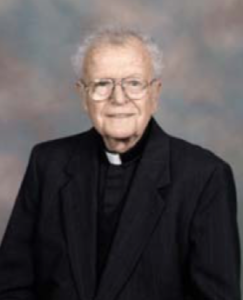Father Francis Rogers
Archdiocese of Philadelphia

Ordained: 1946
Retired (in good standing): 1995
Died: 2005
Assigned as follows:
- 1946-1949: St. Patrick (Pottsville, PA)
- 1949-1952: St. Hugh of Cluny (Philadelphia, PA)
- 1952-1953: Holy Martyrs (Oreland, PA)
- 1953-1959: St. Rose of Lima (Eddystone, PA)
- 1959-1961: St. Francis of Assisi (Norristown, PA)
- 1961-1962: St. Carthage (Philadelphia, PA)
- 1962-1968: St. Joachim (Philadelphia, PA)
- 1968-1971: Incarnation (Philadelphia, PA)
- 1971-1976: St. Barnabas (Philadelphia, PA)
- 1976-1983: St. Ambrose (Philadelphia, PA)
- 1983-1991: St. Joan of Arc (Philadelphia, PA)
- 1991-1998: St. Timothy (Philadelphia, PA)
- 1998-2005: Villa St. Joseph
Summary of Sexual Abuse Allegations against Father Francis Rogers:
Father Francis Rogers was ordained a priest in 1946 and served in the Archdiocese of Philadelphia. He served in multiple parishes throughout his career. According to the Philadelphia 2011 Grand Jury Report, we “will never be able to determine how many boys Father Francis P. Rogers raped and sexually abused in his more than 50 years as a priest. Nor, probably, will we or anyone else be able to calculate the number of boys the Archdiocese could have saved from sexual abuse had it investigated potential victims rather than protecting itself from scandal and shielding this sexually abusive priest… We find that the Archdiocese received a litany of verifiable reports beginning shortly after Fr. Rogers’ 1946 ordination and continuing for decades about his serious misconduct with, and abuse of, boys.”
One of the earliest known victims of Rogers who could have been protected was “R.” R. was abused in 1962 or 1963 at St. Joachim’s in Philadelphia. He was a 12 year old altar boy abused weekly until he turned 16. The abuse often happened after the priest plied him with liquor and, after ingratiating himself with the boy’s family, on trips out of state. Rogers told the boy that he could never tell anyone about the abuse (which ranged from fondling to regular acts of sodomy) because people would blame the boy’s mother since she was the one who allowed him to spend time with the priest.
-
THERE IS NO QUESTION THE ARCHDIOCESE OF PHILADELPHIA KNEW ABOUT ROGERS’ SEXUAL ABUSE OF BOYS BY MAY 1961
According to the grand jury, “…by May 5, 1961, the date on which the Archdiocese Chancellor…wrote a memorandum to file about then-current reports of Fr. Rogers’ misconduct with boy, Fr. Rogers already had a more than 10-year history of reports of serious misbehavior with boys.” Specifically, the Archdiocese had actual knowledge of misconduct with 8th and 9th grade boys at least as early as 1951, including that he took them out of state, plied them with alcohol and pornography, and took “obscene” photos of them. The allegations went back to 1946, the year he was ordained. Rogers admitted to the allegations in 1961, and disclosed that he was himself a victim of abuse in seminary. Despite the fact that allegations were made in his first three parishes, Rogers was left in ministry without even so much as a psychological evaluation. Instead, in handwritten notes, Cardinal John Krol directed his designee to give Rogers “a severe warning…that any further complaint will call for…transfer to another post.” He was sent on a ten day “retreat” at a Trappist monastery to think about what he’d done.
-
WILLFUL BLINDNESS AND EXCUSES CONTINUE INTO THE 1970S
In 1973, following almost a decade of complaints from parishioners that Father Francis Rogers was neglecting his basic priestly duties, the Archdiocese of Philadelphia received a letter from several mothers at St. Barnabas reporting that, among other things, Rogers was always wrestling with the boys (in a way that was uncomfortable enough to cause them to write to the Cardinal), and often took boys out of school to go for rides in his car without telling their teachers. Notes in Rogers’ file state that the Archdiocese of Philadelphia made a conscious decision to take no action on the complaints, despite the litany of earlier complaints, because it was “anonymous.” The mothers did not provide their names in an effort to protect their children from retaliation.
In 1975, according to documents in Rogers’ personnel file, a Chancery official met with Rogers to explain to him that he would not be promoted to a pastorate because of “the suspicion of patterns…has been in the picture for some time, and I again reminded him that he knows of what I am speaking.” He concluded the meeting by telling Rogers something that the grand jury characterized as, “…despite Fr. Rogers’ lengthy history of suspected sexual contact with boys and his complete failure to demonstrate that he had ceased such behavior, the Archdiocese still regarded him as a candidate for a pastorate.” This followed nearly three decades of empty threats that Rogers would be transferred and/or sent for psychiatric treatment if the allegations against him did not stop. Of course they would not stop when there were no consequences.
In April 1976, Cardinal Krol received two different letters from a parishioner at St. Barnabas who reported misbehavior by several priests, and specifically mentioned that Fr. Rogers’ “chasing of boys is well known.” Despite the fact that this letter was signed by the parishioner, unlike the earlier letter from the group of mothers, there was no action taken by the Archdiocese to investigate or even speak with the author. Instead, Rogers was immediately transferred.
-
FIVE VICTIMS MAKE REPORTS IN LESS THAN FOUR YEARS; ROGERS ADMITS TO ABUSE OF AT LEAST ONE
In 1998, R., one of Rogers’ victims, came to the Archdiocese of Philadelphia to report his abuse. He also provided the name of at least one other victim that he personally witnessed be abused by Rogers. Notes in Rogers’ file contain a summary of the allegations, as well as a summary of all of the reasons that the Archdiocese need not investigate them (e.g., the allegations were from decades before, the priest was in his 70s, etc.). The notes also say that no action would be taken to interview Rogers until after the Archdiocese attorney weighed in on the matter.
When finally confronted some time later, Father Francis Rogers admitted to sexually abusing R. He even provided the name of a second priest who participated in an incident of abuse. R. could not remember the second priest’s name, but described the event in a way that Rogers readily admitted to it. Instead of providing R. with information that Rogers remembered the incident and even provided the name of the second priest, R. was told that they would not provide him with any information about Rogers’ response (including the second priest’s name) because the second priest was dead and unable to defend himself. In 1999, more than a year after he first came forward and without seeking out any additional victims, the Archdiocese launched an all-out offensive on R. A memo from the Archdiocese’s attorney told the Chancery that they were confident they would prevail in litigation if R. ever filed suit because they had, through interviews with other priests who knew R., learned that he had been abused by two other people as a child. Other than paying for some counseling sessions, the Archdiocese of Philadelphia refused any other requests for assistance.
Given that he was retired and older, the Archdiocese temporarily suspended Rogers from ministry and sent him for a psychological evaluation at Villa St. John Vianney, a notorious treatment facility for pedophile priests in Downingtown, Pennsylvania. The recommendations of the evaluating therapist “do not demonstrate even a cursory knowledge of Fr. Rogers’ psychological makeup.”
In January 2002, another man contacted the Archdiocese of Philadelphia to report his abuse from 1959-1961 at St. Francis of Assisi.
In March 2002, a third man called to report his abuse as a 10 year old. He outlined abuse on day trips and with an m.o. consistent with that reported by R.
A fourth man came forward in June 2002. He alleged abuse from 1976-1977 at St. Ambrose. He also identified two other victims who had committed suicide.
In 2004, faced with the possibility of involuntary removal from the priesthood, Rogers agreed to live a life of “supervised prayer and penance” at Villa St. Joseph with other accused priests.
Father Francis Rogers died in February 2005.
Horowitz Law is a law firm representing victims and survivors of sexual abuse by Catholic priests and other clergy in the Archdiocese of Philadelphia. If you need a lawyer because you were sexually abused by a priest in Pennsylvania, contact our office today. Although many years have passed, those abused by Catholic clergy in the Archdiocese of Philadelphia may have legal options, but filing deadlines will apply so please do not delay in reaching out to us.
Contact us at 888-283-9922 or [email protected] to discuss your options today.
